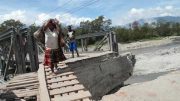2018 started badly for children in Indonesian Papua; though it’s a miraculously fertile province, at least 70 children in the Asmat district died of malnutrition in December and January, and measles and other vaccine-preventable infections are running high. We know about this because Kompas, Indonesia’s leading paper, sent reporters to Asmat to spotlight the crisis. But in truth, it’s probably been going on for a very long time. And it’s probably happening in other parts of Indonesia too; the health ministry’s most recent national health survey shows that over two in five children under 5 are stunted in most of the east of the country. It’s a measure of many things, not least the extreme inequity in access to basic services such as health.
I’ve written before about the flawed miracle of universal health insurance in Indonesia, and charted its improbable history. Recently, I’ve been working with two whip-smart Indonesian researchers, Agnes Pratiwi and Herma Setiyaningsih, to look at why there’s a mismatch between the insurance people have and what they spend on health services. We’re still working on the analysis, but when we took a look at the supply side, we got a pretty good early indication. People in poorer parts of the country spend less on health services not because they are healthier and have fewer health needs, nor because they have better insurance coverage, but because there are simply no health services available to spend money on, whether you’re insured or not.
It was my statistics software, Stata, that really rubbed our noses in Indonesia’s health inequities. We coded our data to reflect the percent of villages in each of Indonesians 519 districts and cities that have no access at all to any kind of health services, and divided them into 5 colour categories, beginning with blue for no villages having no services (i.e. the best access — more about the data below). In the worst category, red, over 40% of all villages in a district had no access to any health service at all: not even a pharmacy. Stata starts drawing from the blue category, and because of the way Indonesia’s provinces are coded, it maps from West to East. When it gets to the end of one category it goes back to the Westernmost point, and starts on the next category. It takes a while for the full extent of the inequity to become apparent (I’ve actually speeded up the video a bit) But you can see for yourself what happens:
A good whack of Sumatra, as well as all of Java and Bali, appear very early, indicating very good access to health services. But the rest of the country barely exists, until we get into yellow territory, where up to a fifth of villages have no access to any services at all. Most of Kalimantan, as well as Eastern Indonesia, begin to appear when over 20% have no health services. And as for the two Papuan provinces, upwards of 40% of villages have no access to any sort of health service, and that holds true for almost all districts.
Emotions always run high when the subject of Papua comes up; for decades, the central government in Jakarta has worked with foreign firms to suck the area’s natural riches out from under native Papuans, using the benefits to fund development in Java and parts West. Over the last decade or so, there has been at least a passing attempt to make amends; in 2017, for example, Papua received 5.6 trillion rupiah (around US$ 420 million) to spend on health and education in addition to its regular budget. That’s for a population of around 5.2 million across two provinces. But that money doesn’t seem to have improved the availability of the most basic health services in many areas. It’s easy to blame Jakarta for that, but the self-entitled Papuan elites have a lot to answer for too. (On the gossip front, I heard that the Bupati of Asmat was reluctant to accompany the health minister to his blighted district; it was too much of an inconvenience to move from his preferred residence in the provincial capital Jayapura, 425 kilometers away. But that is utterly uncorroborated, so take it for what it’s worth.)
Our map suggests, however, that these problems are unlikely to be confined to Papua. Before it takes too much credit for its national health insurance programme, Indonesia’s government needs to think carefully about what services it is actually providing access to.
Notes for Nerds:
The map is made using 2012 shape files (ergo, no North Kalimantan yet). It encodes data collected by BPS in the “Potensi Desa”, a census of every village in Indonesia that takes place every four or five years. Data are collected from the village head. These data are from the most recent survey, 2014, in response to question r704, in which the village head is asked about the availability of various health services. If the answer for a particular service (for example a hospital) is “No”, s/he is further asked “How far is it to the nearest hospital?” and then “How easy is it to get to the nearest hospital: very easy, quite easy, quite difficult, very difficult?” We coded a village as having access to ANY health service if there was a health service in the village, or if it was either “very easy” or “easy” to reach that service from the village. The services we included were: Hospital, Maternity Hospital, Puskesmas with inpatient facilities, Puskesmas with only outpatient facilities, Private clinic, Private doctor’s practice, Private midwife’s practice, Pharmacy. We did NOT include village midwives (who only have informal training), Posyandus or PusTus (Puskesmas Pembantu). Posyandus offer only services related to infant monitoring, and in my experience PusTus outside of Java are very rarely staffed.
Tiwi and Herma work at Pusat Kebijakan Pembiayaan dan Manajemen Asuransi Kesehatan (KP-MAK, the Centre for Health Insurance Policy Studies) at Universitas Gadjah Mada. I was supported to work with them by the Dutch taxpayer, through the Nuffic programme. Thank you. They’re working on a more detailed paper of their findings as we speak, so watch this space.





Brilliant survey – and sadly not surprising results.
My contact with a clinic in Denpasar last year revealed that (underpaid) staff were swamped with patients and referrals to hospitals often rejected as state reimbursements never came. Universal health coverage is totally utopian for such a huge population and, I imagine, a vastly insufficient financial input.
” A native Papuan, Willem Bobi travelled across the vast jungle-covered area and described the dire health situation in a book, The Asmat Medicine Man, which was published last year.
Hi…EP…I’m really interested to your post about our country
I did a JKN evaluation study using IFLS 2014 (excluding most Eastern Indonesia) and found similar finding to what you’ve found: the effect of JKN on increasing utilisation is only positive for people who lived in an area with highest density of health care facilities, either outpatient or inpatient. This finding may be sound obvious but there should be something to be done to advocate this issue better.